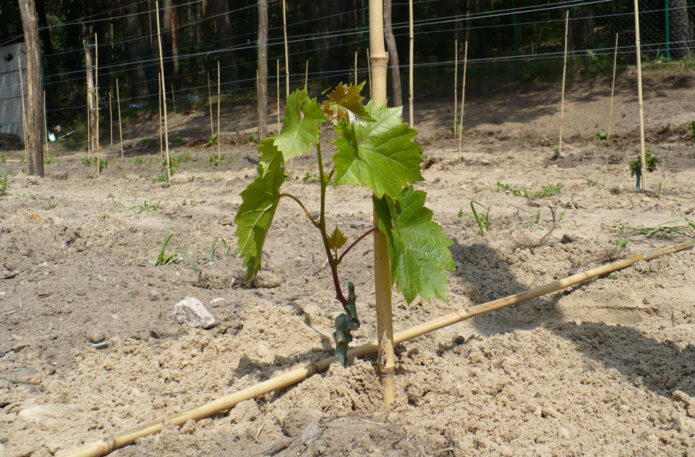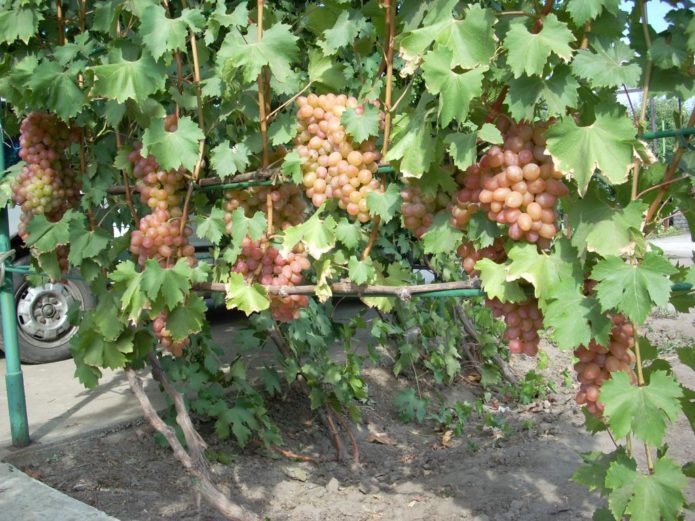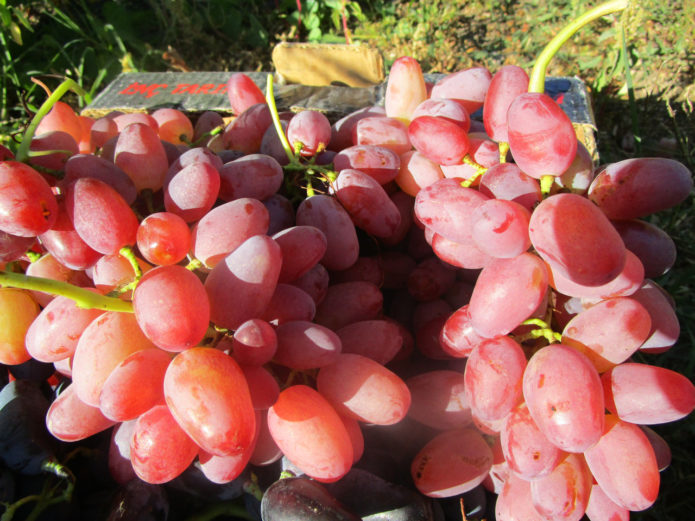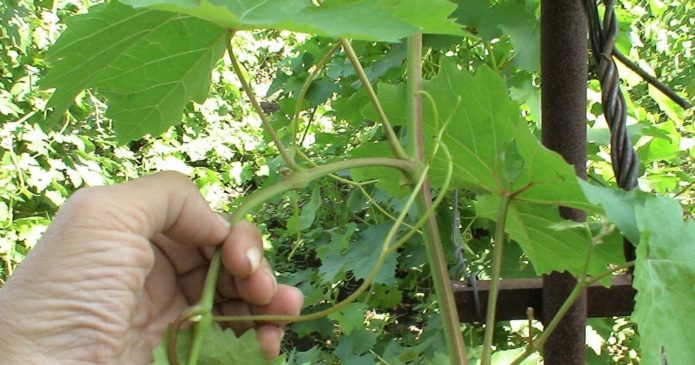Winegrowers are well aware of the Arcadia variety - a wonderful table grape with large yellowish-white fruits of a dessert taste. However, there is also a pink Arcadia, which differs not only in the color of the berries, but also in some other characteristics. This variety bears the official name Helios and is also quite popular, both among amateurs and in the professional community.
Content
Breeding history, description and characteristics of the Helios grape variety
The Helios grape was included in the State Register in 2015, and it was obtained by crossing Arcadia with the Nakhodka raisin variety. This is a variety of the famous Russian amateur breeder V.N.Krainov... All varieties created by him in the city of Novocherkassk, and there are more than forty of them, are distinguished by good resistance to unfavorable climatic conditions and most diseases. Almost all varieties of V.N.Krainov bear fruit with large berries and receive extremely positive reviews from winegrowers.
Helios are super early ripening varieties, the first ripe bunches can be cut already in early August. However, over time, the berries gain more sugar and reach full ripeness closer to September: they need 110-115 days to be fully cooked. Officially, Helios is recommended for regions with a mild climate, but in a covering culture it is successfully grown in central Russia.
Bushes of medium size, with large leaves of the usual form of emerald color. The ripening rate of young shoots in normal years is close to 100%. Reproduction is problem-free: both the degree of rooting of cuttings and their success in grafting on most of the known rootstocks is high. Flowers are bisexual: pollinators of other varieties are not required for Helios. The annual yield is high.
Frost resistance at the level of most modern grape varieties: without shelter, the vine can withstand cold snaps down to -23 aboutFROM... However, its weak resistance to recurrent spring frosts is noted: often grapes bloom at this time, which leads to a significant decrease in yield. Disease resistance is average. An additional positive quality can be considered a weak damage to berries by wasps and hornets.
The variety cannot be considered non-capricious: it does not require anything special from the owner, but care must be complete. Without a sufficient amount of fertilizers, Helios grows poorly and bears fruit poorly, and requires qualified formative pruning.
The bunches are large, conical in shape, weighing half a kilogram and above. With good care, several specimens weighing from 1 to 1.5 kg are necessarily found on the bush. The packing of berries in bunches is medium-dry. The amount of "peas" in the bunches is minimal. The transportability of the crop cannot be considered excellent, but it is stored well in the refrigerator.
Berries are pink, ovoid, very large, about 3.5 cm long, weighing up to 15 g... However, the juice, the amount of which is quite large, is completely uncolored. The content of both sugars and acids in the juice is low: 15% and 5.5 g / l, respectively. The pulp is fleshy, very tasty, with a slight nutmeg aroma. Seeds (1–2 per berry) are medium in size, the skin is firm.
Helios is considered a table variety, but it is also suitable for various types of processing. It makes good compotes, jams, delicious juice. However, the variety cannot be considered optimal for winemaking: although amateurs make wines from it, they are not of very high quality, which, in fact, is typical for the white variety of Arcadia.
Features of planting and cultivation of the Helios grape variety
Agrotechnology of Helios grapes does not have any significant features, but all the necessary measures for caring for it must be carried out accurately and without exception. Like any other grape, it likes well-lit areas protected from cold winds. It is desirable that from the north side it is protected by a house wall or a high blank fence. You can either buy an Arcadia pink sapling, or grow it yourself from a cutting: the variety takes root easily.
When buying a seedling, you need to carefully look so that it has healthy roots. Before planting, the seedling is soaked in water for a day. You can plant grapes in the fall, but more reliably - in the spring, at the end of April. For spring planting, a pit is prepared in the fall, having previously dug up a plot of several square meters with fertilizers, while simultaneously removing perennial weeds. The pit is prepared large, despite the fact that the bushes of Helios are of medium height. The minimum dimensions are 80 cm in diameter and depth.
Drainage at the bottom of the pit (a layer of gravel or broken brick) is necessary on any soil. A layer of fertilizers mixed with the soil removed from the pit should be placed on top of the drainage, and in this layer, which occupies just over half of the pit, there should be more organic fertilizers (compost, humus) than earth. In addition to humus, a couple of liters of wood ash and 300–400 g of nitrophosphate are added. And in the upper part of the pit, where the young roots will be located, only clean fertile soil is placed.
On any soil, except sandy, a piece of a thick pipe must be drawn to the bottom of the pit. Through it, the roots of the seedling are watered for the first 2-3 years. In addition, you should immediately build at least a strong stake for tying up shoots in the first year, and it is better to immediately make a trellis. When planting in spring, the seedling is buried deeply, leaving only two buds on the surface. Thoroughly watering the seedling, mulch the soil around it.

Only one bud can be brought to the surface: anyway, in the first year it is necessary to preserve and grow a single shoot
Caring for grapes includes watering, feeding, pruning, preventive treatments, shelter for the winter. Everything except pruning is very simple, but the art of pruning can and should be learned. Watering is carried out moderate; frequent and abundant is required only in the driest regions. The need for water is especially great during the growth of berries, but from the middle of summer watering should be stopped: the berries should gain sugar and acquire a real taste: after all, many tasters rate it at 9 points! In addition, sub-winter watering is required, especially in dry autumn.
Helios is fed mostly with ashes, filling up at least a two-liter jar under each bush every spring. After a year, one and a half to two buckets of humus or compost are added to the ash. It is necessary to carry out foliar dressing by spraying the leaves. Immediately before the beginning of flowering and at its completion, weak solutions of complete mineral fertilizers are used, and after another two weeks, the nitrogen component is excluded.
Helios has average immunity to most diseases, therefore, two-time preventive treatment is necessary... After the early spring opening of the bushes, the vine is sprayed with a solution of ferrous sulfate, and at the moment the buds begin to bloom, Bordeaux liquid is used. If signs of illness appear, you have to use more serious drugs, for example, Strobi and Topaz. The norms and techniques for the preparation and use of solutions must be strictly observed: all this is prescribed on the packaging of the preparations.
In early spring, before the start of sap flow, cosmetic pruning is carried out. At this time, only clearly dead shoots are removed. It is much safer to prune Helios in late autumn after the leaves have fallen off. The most intense pruning work is carried out in the summer, when at each visit to the bushes they are examined for the appearance of unnecessary green shoots. They are removed while they are very young. In addition, it is necessary to ration the harvest, removing excess clusters immediately after flowering and germination of berries. On each shoot, no more than two or three bunches have to be left, although the bush tries to "stretch" more. In the final autumn pruning, only 6–8 buds are left on the shoots. The total load on the bush should be no more than 35–40 eyes.
Before the onset of frost (closer to the beginning of November), all vines must be removed from the trellises, conveniently laid out on the ground and covered with any suitable materials. In the middle lane, dry foliage of trees is enough for this, and better - spruce or pine spruce branches.
When sheltering bushes, poisonous bait for rodents, which are very fond of eating bark in winter, should also be laid out nearby.
Video: load on the Helios bush
Advantages and disadvantages of the variety in comparison with similar
If we compare Helios with his “mother” - ordinary Arcadia, it turns out that they are similar in most of their characteristics. True, some grape lovers do not really like the color of the berries of indistinct pink tones. Apparently, we should agree that the classic white color looks stricter. But Helios ripens much earlier, although it reaches full ripeness by about the same time as Arcadia. But from the point of view of the full readiness of grapes for consumption at a record early date, many other varieties have appeared in recent years, including those with more beautiful berries.
Nevertheless, trying to compile lists of pros and cons of the variety, we have to admit that there is only one obvious drawback: this variety is extremely demanding for careful observance of all the rules of agricultural technology, otherwise it will hurt and bear poor fruit... Can this be considered a disadvantage? Apparently, yes, because because of this, the variety is difficult to recommend to novice summer residents.
The undoubted advantages include the following positive qualities:
- great taste of berries;
- early, albeit prolonged, ripening;
- stable high yields;
- minimal attack by wasps;
- lack of "peas" in the bunches;
- high commercial quality of the crop;
- good immunity to most grape diseases;
- ease of reproduction.
According to the given characteristics, the Helios grape can be classified as one of the best table grape varieties of early ripening.
Video: expert opinion on the Helios grape
Winegrowers reviews
I had the first Helios berries in the vaccine. The size and shape of the berry just surprised me. The berries are dense, crunchy, although no nutmeg has yet been found.
The wasp does not touch my Helios, does not crack, the brushes are beautiful up to 2 kg. I pulled out the load, more than the others. I haven't eaten a single brush, I'm not very good at it.I'm not going to clean it up, people like the taste, and it decorates the showcase, even some people specially came for it. There are no comrades for taste and color.
Our Helios is a very powerful bush. The bunches were at first nondescript. They were in the stage of "green peas" for a very long time, and already closer to mid-August they suddenly began to pour berries, catching up with Krainov's Troika in appearance! The first fruiting, immediately pulled a good load, I don’t remember exactly, but there were five large bunches ... The stability is excellent, absolutely not a problem variety! Very beautiful - bright pink large berries immediately attract attention. But ... Maybe I'm already "spoiled", but my taste is nothing special ... And the skin, as for me, is rather dense ... IMHO This bunch weighed 3,765, once one fit in a box, it was bought without even trying, confirming that many “Buy with your eyes”!
Signals of Helios ripened for me simultaneously with Arcadia. True, he gave them in the third year of planting greenery (like Aladdin). He left two brushes, one kilogram each. He pulled out perfectly, drove out powerful vines, ripened well. The berries are large, beautiful, good taste.
I have Helios first fruiting. When she planted, they did not advise. But, I was pleasantly surprised. No illnesses, vigorous, left three brushes. They grew by leaps and bounds. Now such cute little buns. The berry is large, clean, without peas. True, not yet colored, but already sweet. I thought to re-graft, now let it grow.
Grape Helios (Arcadia rosea), subject to careful observance of the rules of cultivation, gives high yields of berries of excellent quality, which is successfully used by professional growers who grow berries for sale. However, some capriciousness of the variety does not allow us to say that it can be planted in any summer cottage: for novice gardeners there are a lot of other varieties that are easier to care for.






